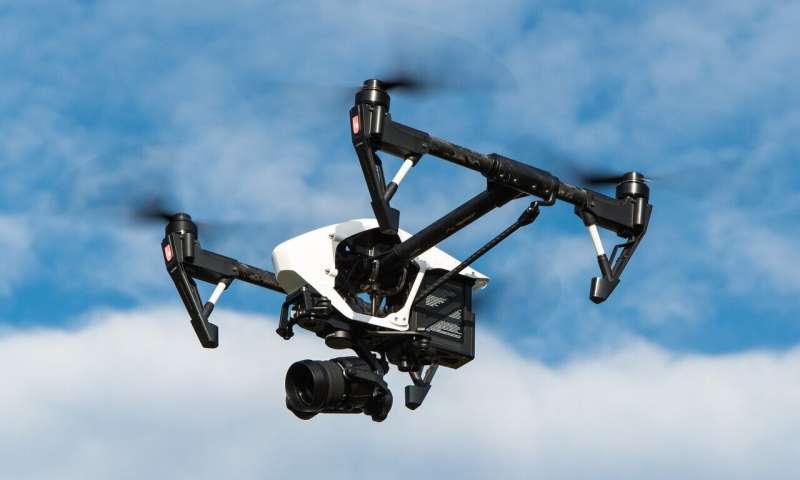This article has been reviewed according to Science X's editorial process and policies. Editors have highlighted the following attributes while ensuring the content's credibility:
fact-checked
trusted source
written by researcher(s)
proofread
Drones could revolutionize the construction industry, supporting a new UK housing boom

The UK's new Labor government has pledged to build 1.5 million homes during its first term in office. To achieve this, it promises planning reform and the reintroduction of local housing targets. Yet little attention has been given to the role of new technologies.
Drones have the potential to transform the construction industry in the UK. However, our recent study in ACM Journal on Responsible Computing reveals that laws governing commercial drone deployment in the UK remain conflicting, chaotic, and sometimes, contradictory.
A drone, or unmanned aerial vehicle (UAV), is a remote-controlled flying machine often equipped with a video camera or sensors. In construction, drones can monitor site progress, conduct safety inspections and even lift heavy materials, with some models capable of lifting over 20kg.
This makes them a viable, cheaper and safer alternative to human construction workers for certain tasks. For instance, drones could reduce the incidence of workers falling from heights, the leading cause of fatalities in the construction industry. They can also lower the cost of site monitoring at night and perform safety inspections over large areas of land, aiding in the maintenance of energy pipelines and other infrastructure projects.
Despite these advantages, the UK's drone policy is a patchwork of local bylaws, national legislation, and retained European Union (EU) rules, creating a confusing landscape for companies to navigate.
For example, to operate a 250g drone in a busy urban area, a company must register the drone, undergo pilot training, secure insurance, and obtain operational approval from the Civil Aviation Authority (CAA). This involves designating a flight plan, conducting risk assessments and completing other administrative steps.
Companies must then consider legislation on privacy, data, harassment (for drones that use cameras), noise and human rights, including the potential redundancy (or reskilling) of human workers.
Specific laws also apply to drones in construction, including lifting regulations, worker health and safety laws, and laws governing the transport of various construction materials and substances. Some of these laws differ on a local, national and international level.
This increases the regulatory burden on construction companies, making it more challenging to operate efficiently. Paperwork for the CAA's approval process for higher-risk commercial use cases can introduce delays to large-scale construction projects. Currently, there is minimal transparency on which projects get approved or denied, leaving business uncertain about their investments until approval is granted.
New framework
Our study proposes creating a new national framework for commercial drone deployment, encompassing all benefits and risks under a single law. We suggest that certain use cases, particularly in regional areas, be greenlit quickly and by default, even for heavier drones.
Line-of-sight requirements—where operators must maintain a line of sight with their drone at all times—should be relaxed in hazardous areas. This could actually enhance worker safety by allowing drones to operate independently without requiring workers to follow them into dangerous situations.
In addition to humans, the law must also protect flying animals (such as birds and bats) and insects (such as butterflies and bees), especially those that are in danger of extinction.
The environmental impact of drones needs to be carefully evaluated, including the risk of fire if drones are carrying chemicals or other dangerous materials.
The UK government should leverage national scientific and technical expertise to produce how-to guides, compliance manuals, and other tools to expedite the approval process.
These resources would allow best practices to proliferate in the industry. Off-the-shelf flight paths, algorithms and application programming interfaces (APIs)—a way for two or more computer programs to communicate with each other—should be available for companies to operate in designated zones without lengthy documentation processes.
Basic plans should be made for drone "elevators" to operate internally in construction sites, to lift heavy materials between floors.
Unifying laws
National legislation could streamline all the attempts to mitigate the risk posed by drones into a single unified law. This would address privacy, noise, safety, human rights concerns, and the environment in one go.
This would include noise profiling, to ensure that drones operating in cities meet specific maximum noise levels. It would also encompass clearer guidance for businesses on the uses of drones that were permitted and those that are prohibited. A new drone law for commercial use could also specify technical requirements, safety features, privacy protocols, and cybersecurity measures to keep hackers out.
The current laws governing drone use are based on the notion that a human decides the drone's trajectory. As AI becomes more integrated into decision making and moves towards full autonomy, some thought will be required about regulating AI itself.
Who will be responsible if a control program does not work as intended? What kind of disclaimers are needed? Another consideration is that AI techniques are based on statistics over limited data. This means that they may never achieve the ISO safety standards that form vital benchmarks for the construction industry.
Integrating drones into the UK's construction industry could significantly benefit a new housing boom, providing cheaper, safer, and more efficient construction processes. However, the government must embrace this technological revolution and establish a more robust drone policy and regulation to pave the way for future advancements.
This article is republished from The Conversation under a Creative Commons license. Read the original article.![]()


















